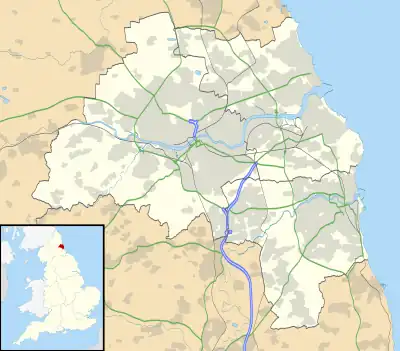| St John's Church, Gateshead Fell | |
|---|---|
.jpg.webp) | |
 St John's Church, Gateshead Fell Location in Tyne and Wear | |
| 54°56′18″N 1°35′19″W / 54.9383°N 1.5885°W | |
| OS grid reference | NZ 265 605 |
| Location | Church Road, Sheriff Hill, Gateshead, Tyne and Wear |
| Country | England |
| Denomination | Anglican |
| Website | St John, Gateshead Fell |
| History | |
| Status | Parish church |
| Dedication | John the Evangelist |
| Architecture | |
| Functional status | Active |
| Heritage designation | Grade II |
| Designated | 26 April 1950 |
| Architect(s) | John Ions |
| Architectural type | Church |
| Style | Gothic Revival |
| Groundbreaking | 1824 |
| Completed | 1825 |
| Construction cost | £2,742 |
| Specifications | |
| Materials | Stone, slate roof |
| Administration | |
| Province | York |
| Diocese | Durham |
| Archdeaconry | Sunderland |
| Deanery | Gateshead |
| Parish | Gateshead Fell |
| Clergy | |
| Vicar(s) | Revd Danie Lindley |
| Assistant priest(s) | Revd Ken Coulson |
| Curate(s) | Revd John Mayes |
| Laity | |
| Churchwarden(s) | Catherine Mayes Yvonne Stonebank |
| Parish administrator | Diane Kindred |
St John's Church, Gateshead Fell, is in Church Road, Sheriff Hill, Gateshead, Tyne and Wear, England. It is an active Anglican parish church in the deanery of Gateshead, the archdeaconry of Sunderland, and the diocese of Durham.[1] The church is recorded in the National Heritage List for England as a designated Grade II listed building.[2] It was a Commissioners' church, having received a grant towards its construction from the Church Building Commission.[3] The church stands at the highest point in Gateshead.[4]
History
In 1809, the Enclosure Act decreed that there be a church built on Gateshead Fell and an acre of land was set aside for that purpose.[5] A grant of £1,000 (equivalent to £90,000 in 2021)[6] was given towards its construction by the Church Building Commission.[3] Designed by John Ions,[2] the foundation stone was laid by Rev. John Collinson, at a "lofty eminence" on Sour Milk Hill, on 13 May 1824.[5] Building continued into the next year and the church was consecrated on 30 August 1825.[5] The total cost was £2,742 (equivalent to £260,000 in 2021).[6][7] In the 1990s alterations were carried out at the rear of the church to create meeting rooms, toilets, and a kitchen.[4]
Architecture
St John's is constructed in ashlar stone with a Welsh slate roof. Its architectural style is Gothic Revival. The plan of the church consists of a nave, a short chancel, and a west tower with a spire. The tower also has diagonal buttresses and an embattled parapet. The windows along the sides of the church are lancets.[2] The two-manual organ was made by Harrison and Harrison. It replaced an organ made in about 1929 by Blackett and Howden, and was installed in 2000. The organ was formerly in St Aidan's Church, Blackhill, Consett.[8]
See also
References
- ↑ St John, Gateshead Fell, Church of England, retrieved 16 December 2011
- 1 2 3 Historic England, "Church of St John, Gateshead Fell (1277868)", National Heritage List for England, retrieved 16 December 2011
- 1 2 Port, M. H. (2006), 600 New Churches: The Church Building Commission 1818-1856 (2nd ed.), Reading: Spire Books, p. 326, ISBN 978-1-904965-08-4
- 1 2 The Building and Parish, St John's, Gateshead Fell, retrieved 16 December 2011
- 1 2 3 MacKenzie, E & Ross, M (1834): An historical, topographical, and descriptive view of the county palatine of Durham p. 107 oclc 59482663.
- 1 2 UK Retail Price Index inflation figures are based on data from Clark, Gregory (2017), "The Annual RPI and Average Earnings for Britain, 1209 to Present (New Series)", MeasuringWorth, retrieved 11 June 2022
- ↑ Lewis, Samuel (1831): A Topographical Dictionary of England, Lewis & Co, p. 217 ISBN 0-8063-1508-3.
- ↑ Durham (Tyne and Wear), Gateshead--Gateshead Fell, St. John, Low Fell (D07943), British Institute of Organ Studies, retrieved 16 December 2011